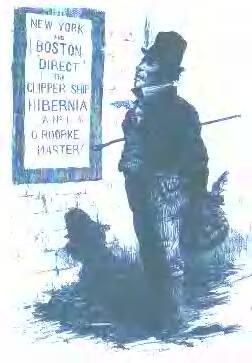The Irish Potato Famine

The Potato Comes to Ireland
Many countries in Europe paid very little attention to the arrival of the potato from the New World. This is because most countries already grew enough food to feed their population, and so there was no reason to grow a new vegetable in large numbers. However, the situation was different in Ireland.
During the 1500's Ireland was torn apart by constant warfare between the country’s English rulers and Irish inhabitants, and between local nobles who were always fighting one another. As a result of this continual conflict, Ireland's peasant farmers had a hard time growing enough food to feed themselves, let alone anyone else. It was into this starving, war-torn Ireland that the potato was introduced around the year 1600.
The Potato Catches On
No one is sure exactly who introduced the potato to Ireland. Some believe it was the famous English explorer, sea captain and poet, Walter Raleigh. Others speculate that the potato washed up on the beaches of Ireland as part of the shipwreck of the Spanish Armada, which had sunk off the Irish coast in a violent storm.
However it arrived, one thing can be said for certain - the potato caught on very quickly in Ireland. The potato's popularity was based on the potato producing more food per acre than any other crops Irish farmers had grown before. In peaceful times the potato spread throughout Ireland as a healthy and reliable source of food. In times of war it was popular as well. When soldiers destroyed farmers' crops and livestock - as soldiers often did -, the potato would survive because it was hidden, buried below ground. When the soldiers left, people could still dig up potatoes and eat them.
Dependent on the Potato
Ireland was the first country in Europe where the potato became a major food source. By the 1800's, the potato was so important in Ireland that some of the poorer parts of the country relied entirely on the potato for food. Because the potato was so abundant and could feed so many people, it allowed the population of Ireland to grow very quickly. By 1840, the country’s population had swelled--from less than three million in the early 1500's to a staggering eight million people--largely thanks to the potato. Some men and women tried to warn everyone that it was dangerous for so many people in one place to be dependent on just one crop. Unfortunately, no one listened to their warnings.
The Famine Strikes
The blight appeared in Ireland in 1845. The blight was the fungus Phytophthora infestans which destroyed potato plants and was the principal cause of what came to be known as the Irish Potato Famine. The blight wiped out the potato crop in 1845, 1846 and again in 1848. People were left with nothing to eat and no way to make money to support themselves. Many wandered the countryside, begging for food or work. Others ate grass and weeds to survive. Those who could afford to, left the country in search of a better life.
(see science&tech - Diseases - for a description of potato blight)
Over the course of the famine almost one million people died from starvation or disease. Another one million left Ireland, mostly for Canada and America. Of those who left, many died on board the boats they were travelling in because the conditions were so crowded and dirty. For this reason, the ships that carried Irish immigrants to the New World became known as "coffin ships". Unfortunately immigrants to the New World soon found out that the blight was ravaging potato crops there as well.



0 Comments:
Post a Comment
<< Home